NOVEMBER 17, 2021: Up to now we zig-zagged through Portugal heading north from Lisbon to Porto. From Porto, we basically headed east along the Douro River, and then last night we drove north-east to Bragança – in the very north-east corner of Portugal. Today, we changed direction and drove south for the first time.
The day started in Bragança. We arrived last night in the dark and had no idea what the city or the surrounding countryside looked like. In the morning light, from the window of the apartment we saw the usual red-tiled roof houses and some low apartment buildings. As in many cities here, there was a small river flowing in the middle of the city.
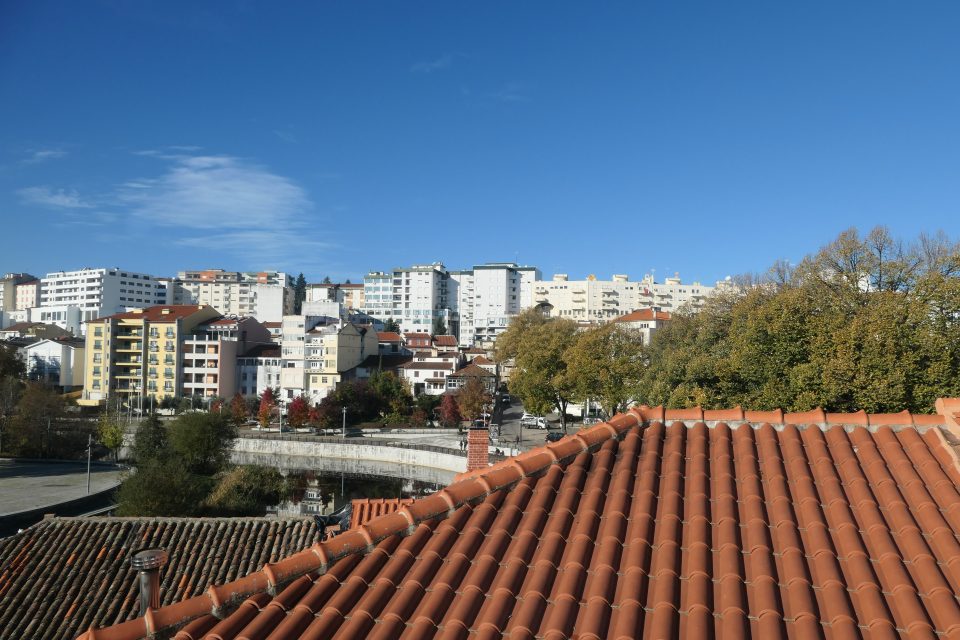
Bragança – view from our window
In Bragança, we intended to visit two sites – first the Center for the Interpretation of Sephardi Culture and then the Sephardic Memorial and Documentation Center. We arrived at the Center for the Interpretation of Sephardi Culture after ten o’clock, and it was supposed to be open, but the doors were locked. Serendipitously, right next door was a Tourist Information office. We went in, and the worker reassured us that the center will open soon. We asked her if she knew anything about the Jewish History of the town. She suggested we go to the other Tourist Information office and ask Anabela – she knows lots about the Jews in this area.
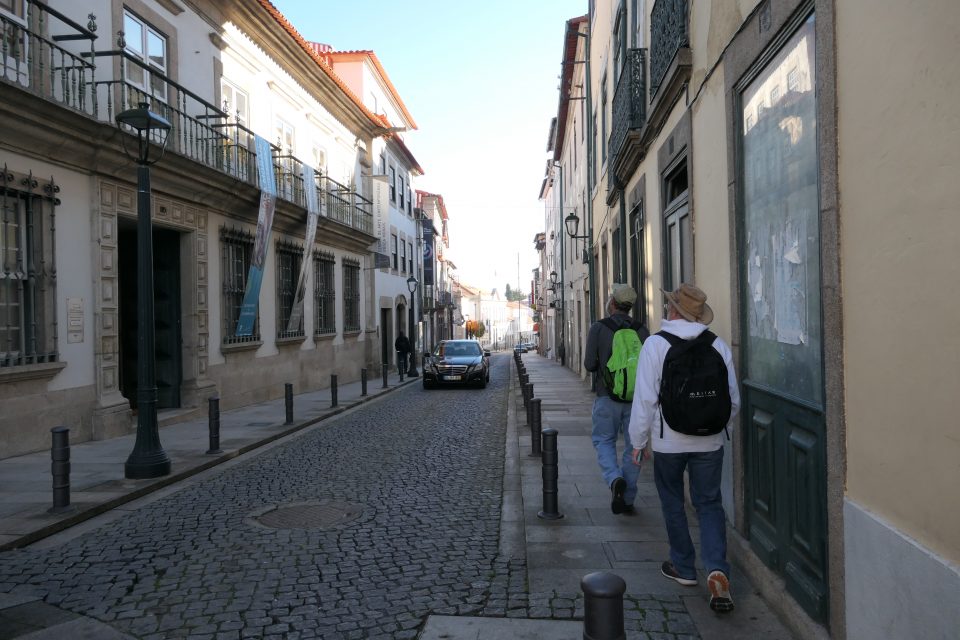
In the historic district of Bragança
We heard the doors opening next door and went into the Center for the Interpretation of Sephardi Culture. This center has the goal of revisiting the lives and experiences of the Sephardic Jews of the region.
The museum was very well done. Spanning two rooms over two floors, as stated in its goal, it concentrated mostly on the Jews who came from the area. One name that was mentioned that I recognized was the impressionist artist Jacob Camille Pissarro. His grandparents came from this region. Other notable names were Jacob Rodrigues Pereira, born in 1715 and dedicated to the education of deaf-mute children, Jacob de Castro Sarmento born in 1691 and a man of science, and several more. Another remarkable display they had, was a movie that reenacted an inquisition trial. It has three characters around a large table. At the head is the Catholic clergyman, along the side sits the scribe writing down every word (the inquisition trials were very well documented in manuscripts that still exist in various archives till today), and at the foot of the table, sat the accused. They asked him questions such as, do you put on clean clothes on Friday night? Do you put new oil and wicks in the lamps on Friday night? Do you bury your dead in a shroud? When you buy meat, do you drain out the blood? All this to ascertain if he was a Jew. It was interesting that all the questions referred to acts that identify practicing Jews till today.
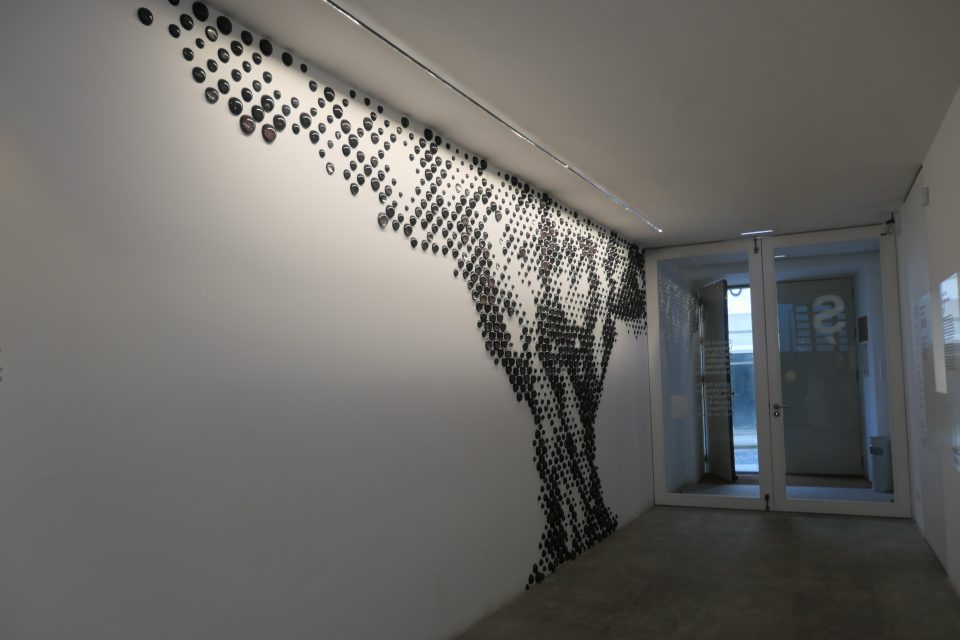
The entrance to the Center for the Interpretation of Sephardi Culture. 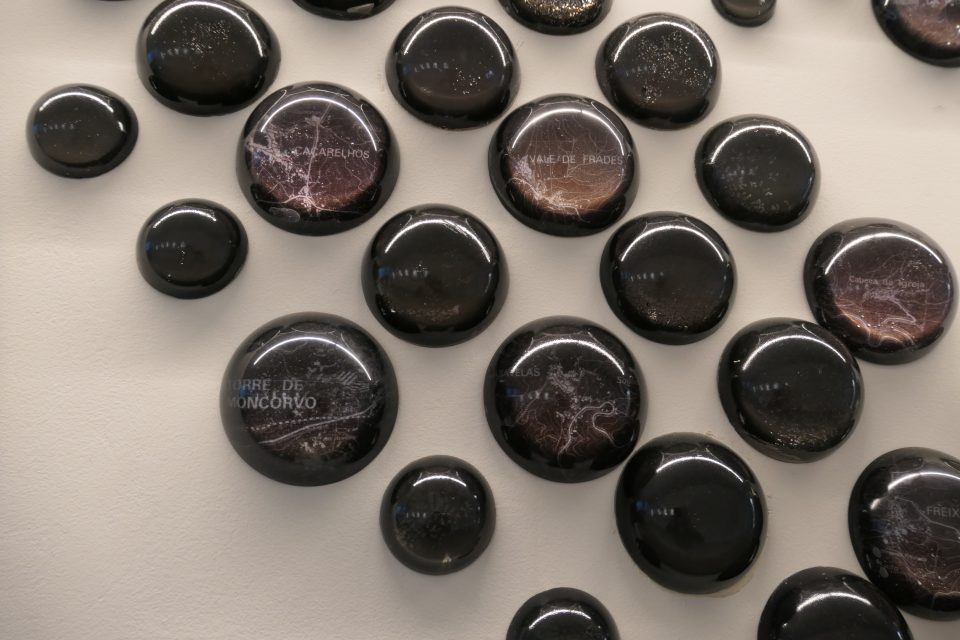
The circles hold the names and maps of the Jewish communities in the region. 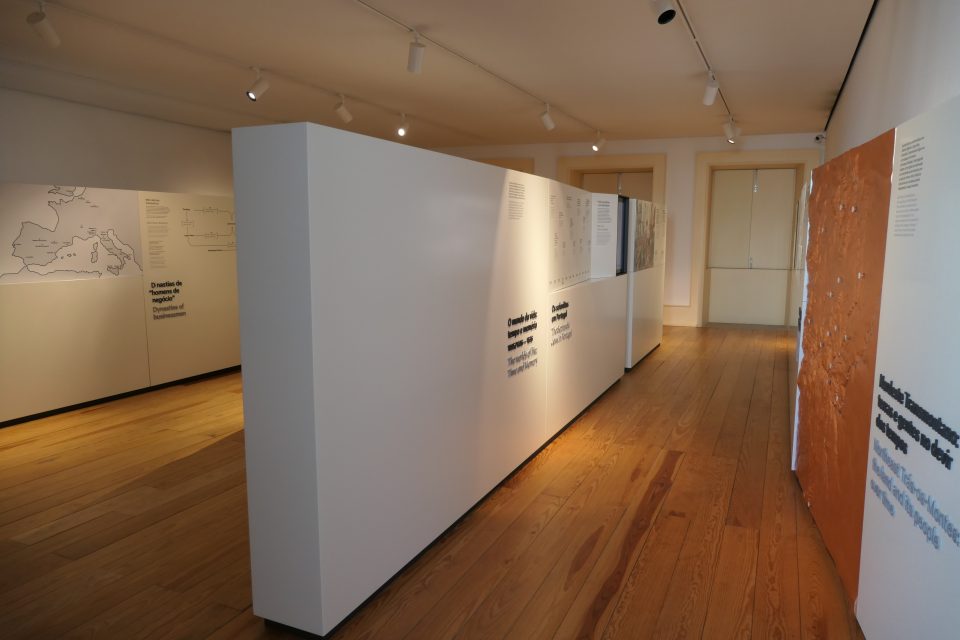
Inside the museum 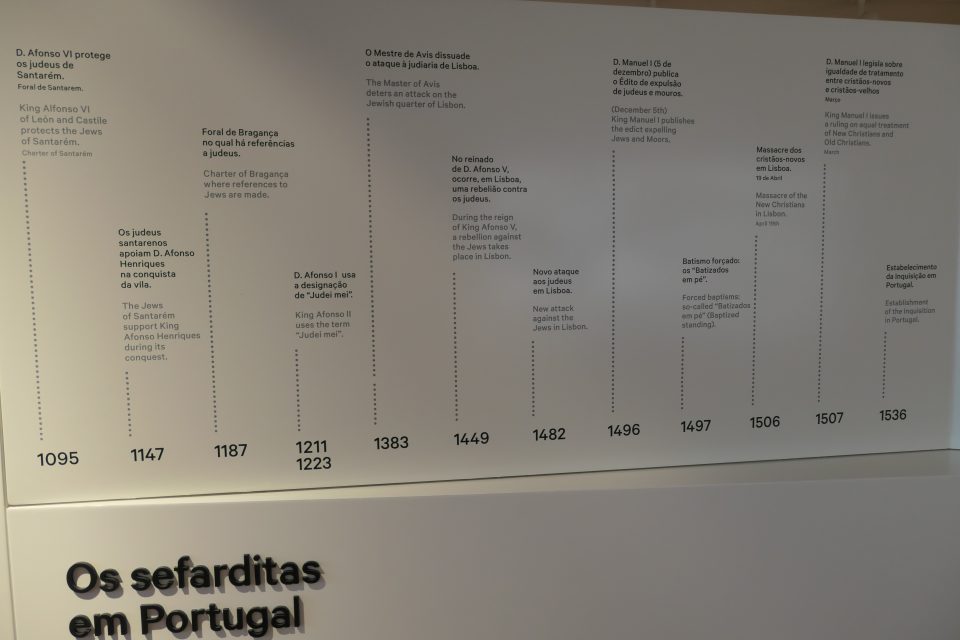
A timeline of Jewish history in Portugal 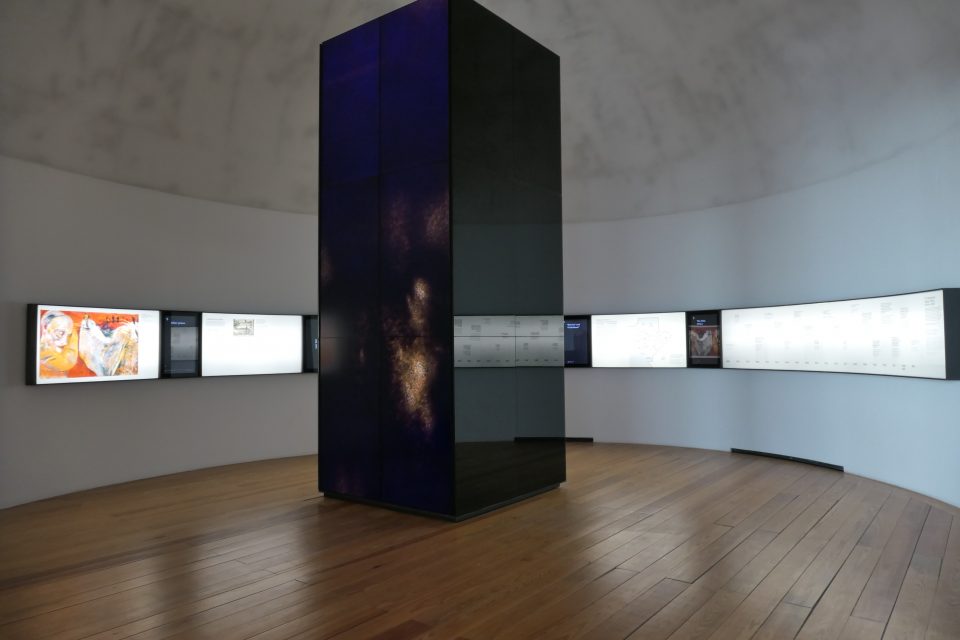
The second floor devoted to the inquisition 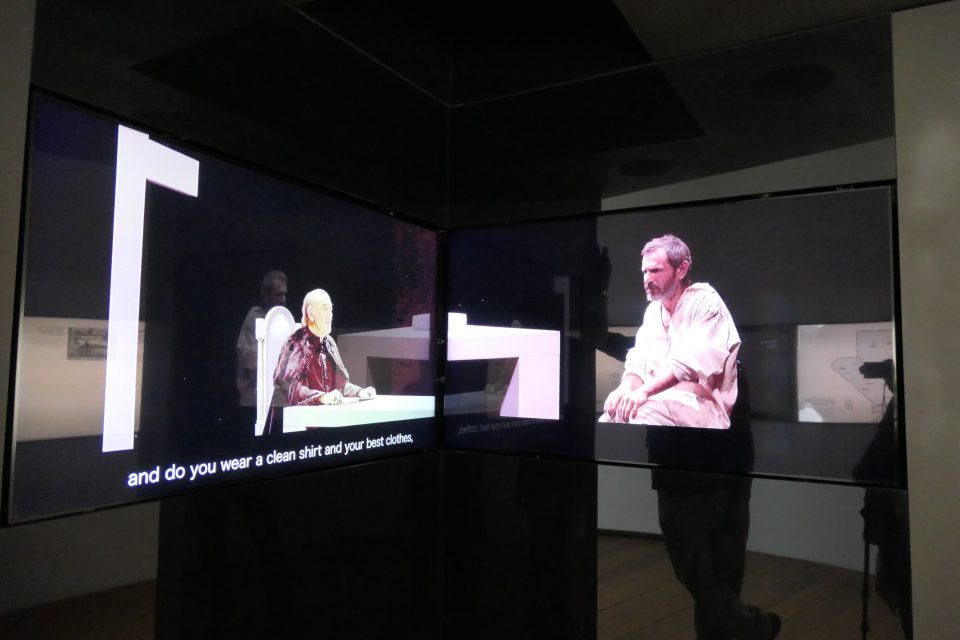
A scene from the movie that reenacts an inquisition trial
The woman, who barely spoke English, at the entrance desk told us that the second place, the Sephardic Memorial and Documentation Center is closed. After a visit that was very enlightening, we exited the museum and walked through the town. The streets were mostly deserted. While some houses had been renovated, many had not. We made our way to the other Tourist Information office.
We entered and told Anabela that we are interested in the Jewish history of the area. She, very excited to talk to us, had us sit down and proceeded to tell us the whole history of the Jews in the region in great detail. She was super knowledgeable – she herself has two last names common to many crypto-Jews – and she showed us the family tree she is working on to find her roots. Like we had heard before, she said that most Portuguese have Jewish blood.
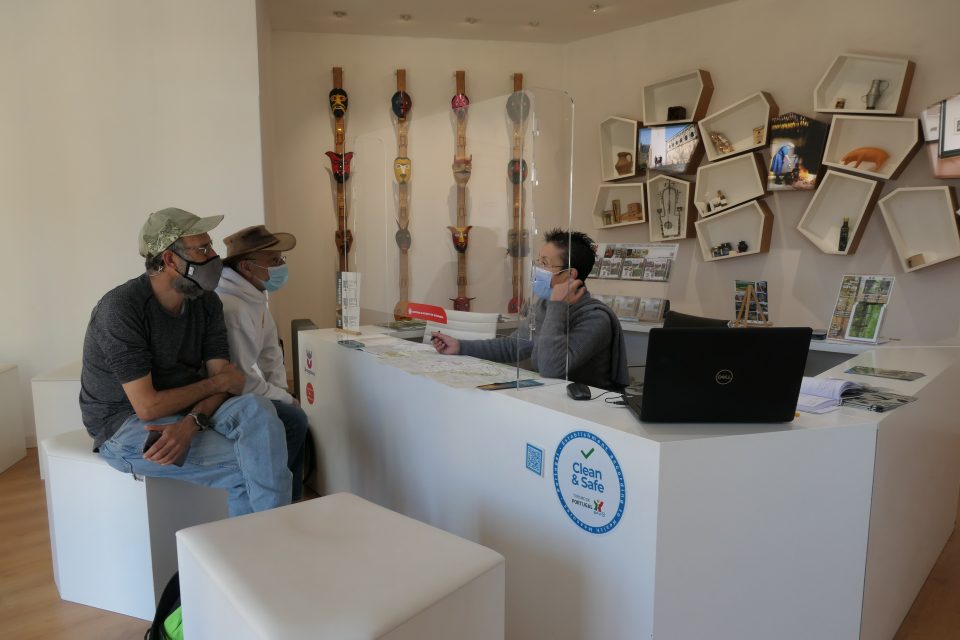
Anabelle in the Tourist Information office
We learned that in 1492, Bragança took in over 3000 refugees from Spain. This was a large percentage of the city’s population, and they quickly became an important economic factor. On the map, she showed us that there had been two Jewish communities in the city. The first was in the old city inside the medieval walls. They know there was a Jewish community there with a synagogue, but today there is no sign of it. The second community, in the early 1900’s, was centered around a house in the historic district used as a synagogue, that was organized by Captain Barros Basto. The building is still there, but there is nothing that shows that is once was used as a synagogue. We stayed over a half an hour listening to her in fascination – it was a pleasure to finally we meet someone who could address our questions.
One of the questions we ask her, was if she knew the burial place of Captain Barros Basto. She did not know. However, in the evening she sent us an email with a link to a Portuguese television broadcast from 1996 about the life of the captain. She wrote that it shows his grave and the cemetery it is in. The broadcast does not name the cemetery, but I compared the gates of the cemetery in the movie, to several of the gates of cemeteries in Amarante that are visible in Google street view. I made a match, and now we know for sure, that yes, he was buried in a cemetery, and the cemetery location. The tourist information of Amarante had steered us in the wrong direction. Thank you Anabela!
We also learned from Anabela that inside the Sephardic Memorial and Documentation Center, that we were told is closed, is a synagogue that is used when groups come, and is opened on request. Unfortunately, we had much more to see today, and did not have time to return to the museum and ask them to open the memorial. Always leave something for next time.
We left the Tourist Information center and made our way to the castle. As usual, in Bragança there is a castle at the top of the hill in the middle of the city. We entered the small walled city and walked through the lanes, not expecting to find and not finding any signs of the former Jewish quarter that was there.
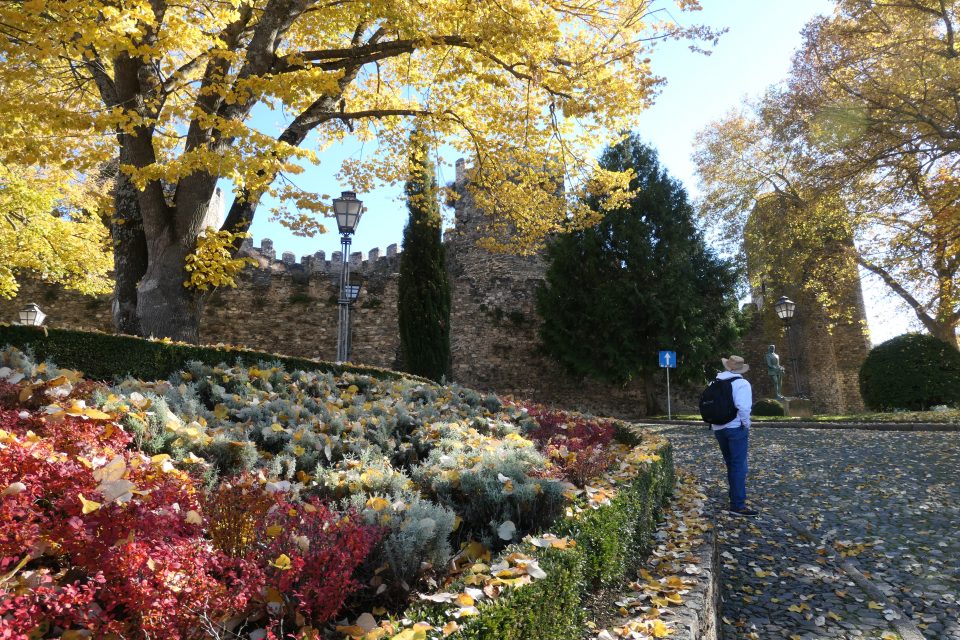
Entrance to the medieval walled city of Bragança 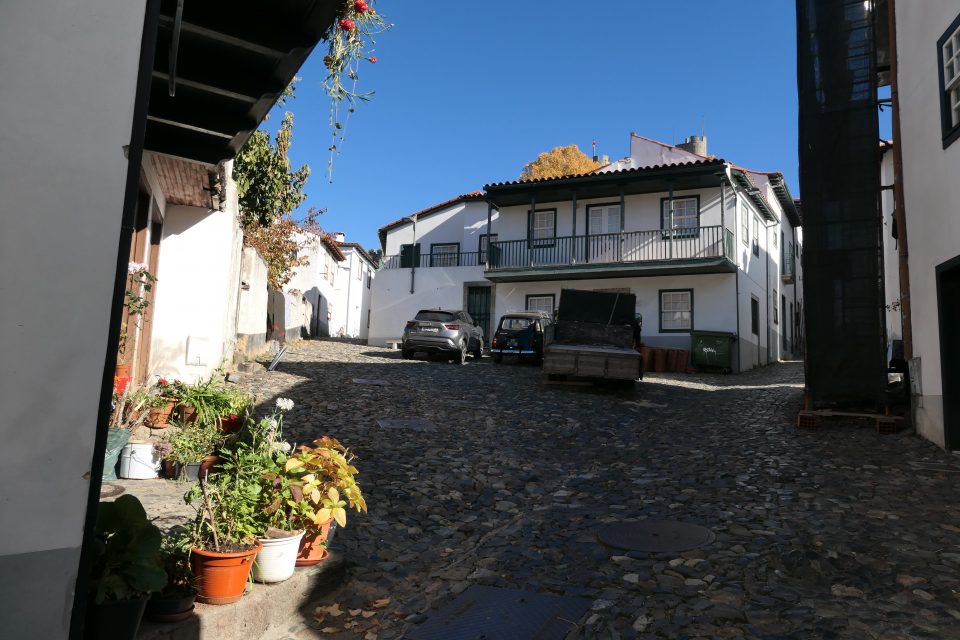
Inside the walled city 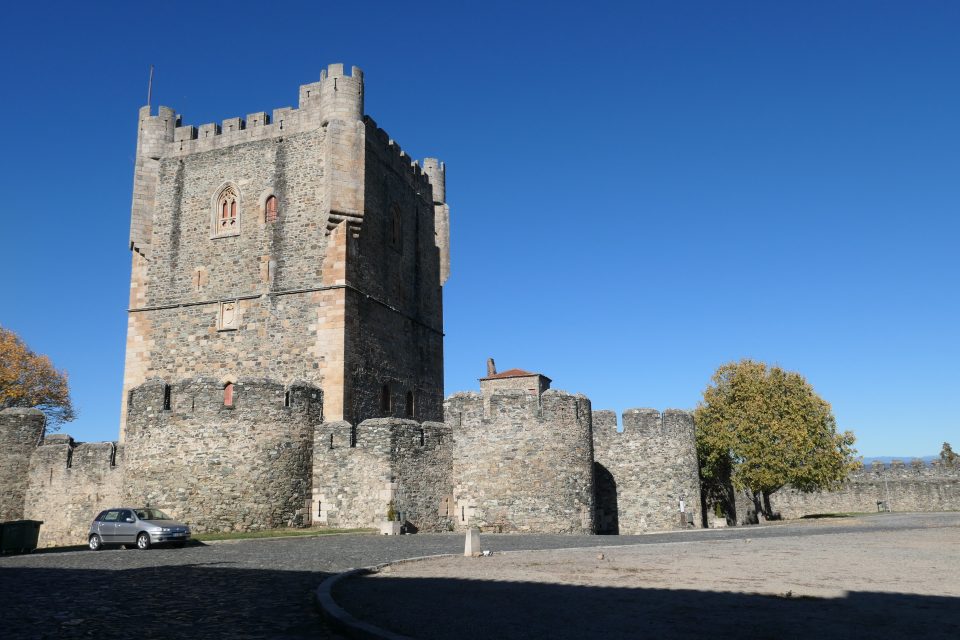
The Bragança castle
Outside the medieval city walls, we went to the address of the synagogue from the 20th century. Today it is an unremarkable building. Once again, a street in the Jewish quarter was called Rua dos Gatos – street of the cats, why is this name associated with the Jewish quarters?
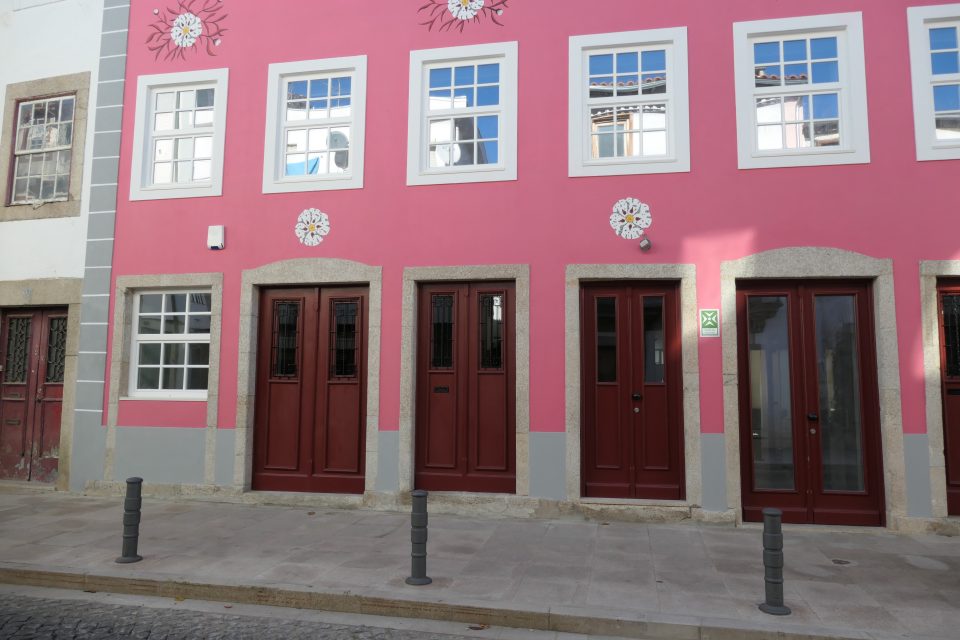
The house once used as a synagogue
One of the influential Jews that came from this area is Orobio de Castro. Isaac Orobio de Castro was born in Bragança about 1620 and was a Portuguese Jewish philosopher and physician. We had read about him in the museum and Anabela also mentioned him in her explanations. We passed a street named in his honor.
We had already spent more time in Bragança than scheduled, and so we returned to our car, and for the first time, headed south. When we drove north from Lisbon to Porto, we were in cities and towns closer to the ocean. Now, as we headed south, we were driving inland, close to the border with Spain. In this region, almost every village has some remains of the Jews. When the Jews were expelled from Spain, many crossed the border into Portugal. This region, therefore saw huge influx of new residents after 1492. In the museum we had just visited, they had a map of the areas where the Jews lived, before and after:
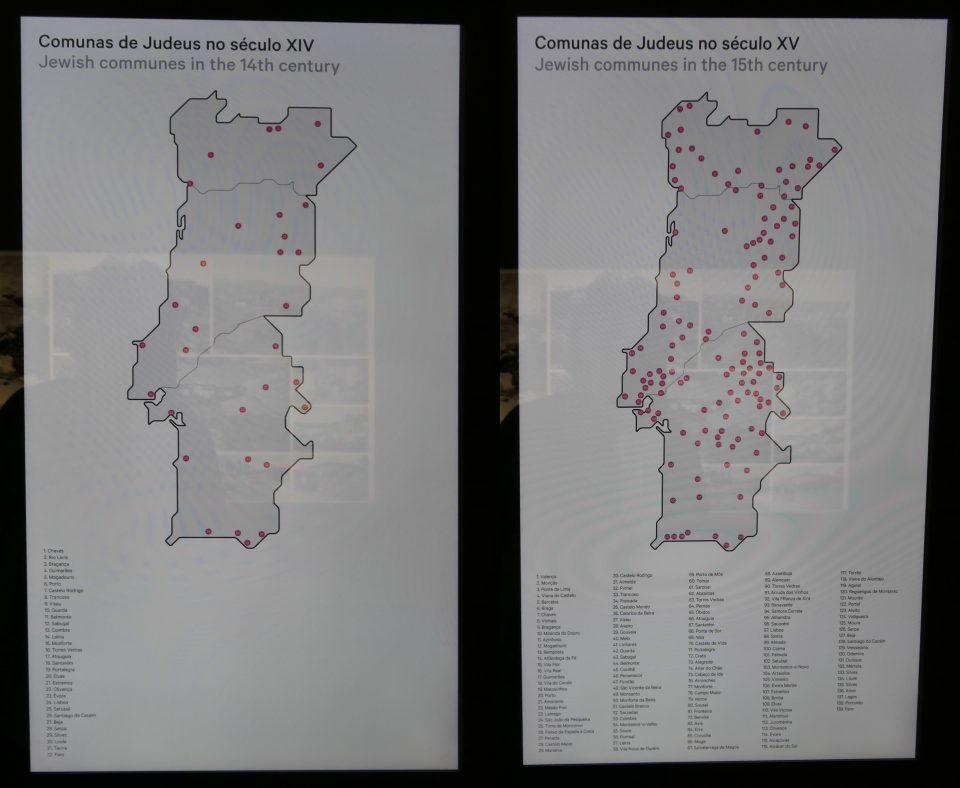
Maps showing how the Jewish population grew in Portugal the expulsion of the Jews from Spain in 1492
The scenery was stunning. We drove up and down mountains, that were too steep for agriculture. The slopes were covered with trees, mostly green with the sprinkling of the fall colors.
Our next stop was a small village that at one point, 50% of the inhabitants were Jewish – Carção. I had one post on Facebook, with a photo of the Museum of the Marranos located there. Other than that, I had not found any other information – no address, no opening hours. We arrived in Carção and parked near the main square. Our first surprise, was to see the logo of the city – it includes a menorah.
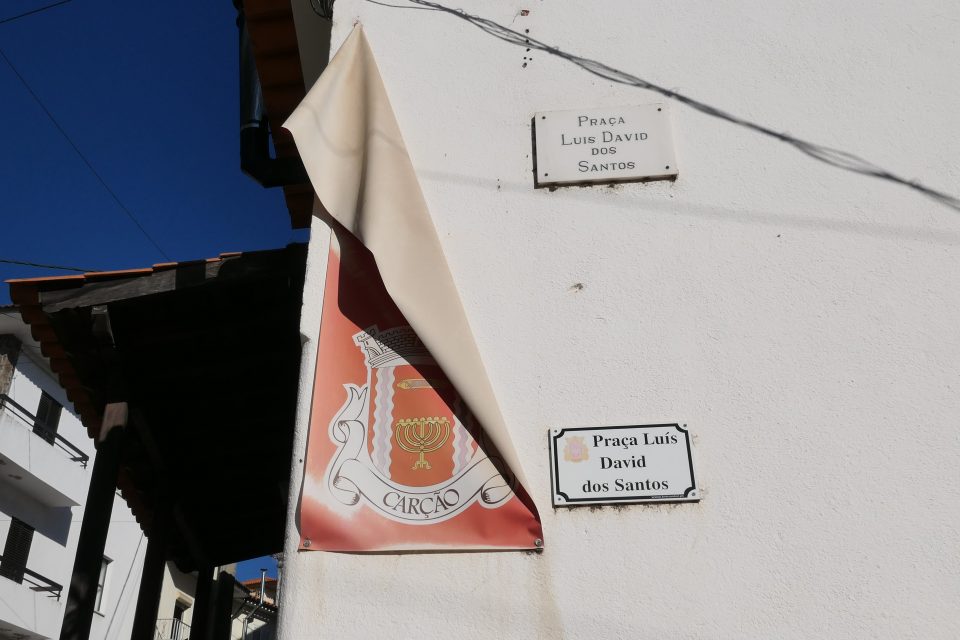
The logo of the village of Carção includes a Menorah
The village is small, and Mark quickly identified the building from the photo. There was no sign that this was a museum – even Anabela told us, she thought it had closed. The place was too small to support a museum. We knocked on the door and there was no response. Across the street a group of locals where sitting and chatting, and saw us try to get in. The woman in the group, approached us and gestured that she can let us in. She brought a key and opened the door.
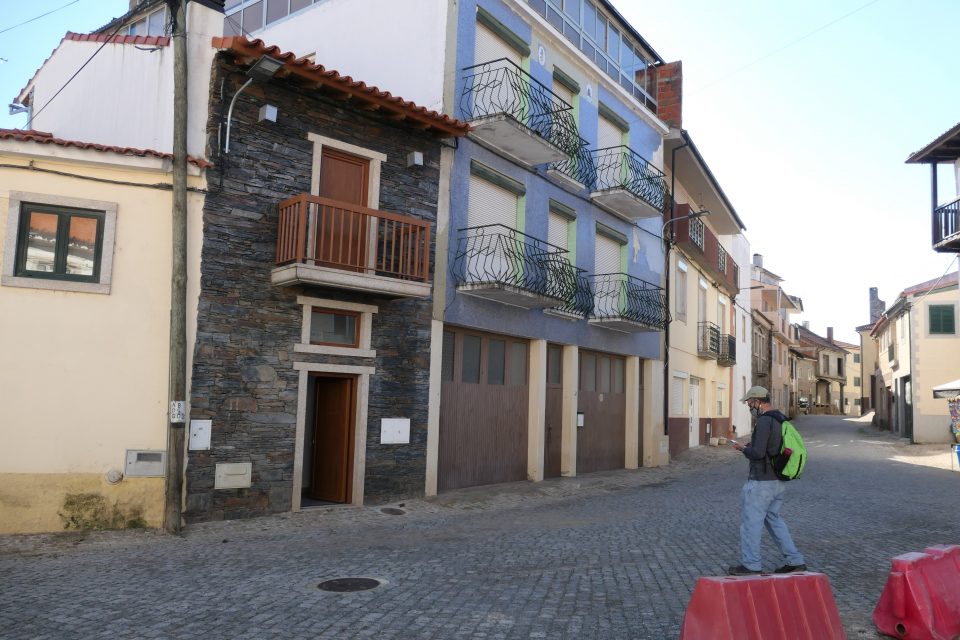
The stone building is the Marrano Museum of Carção. We only found it because we had a photo someone posted on Facebook. There is no signage.
Here was a very small museum on two floors of the house. It had some samples of the carvings in stone on doorposts that we had been looking for.
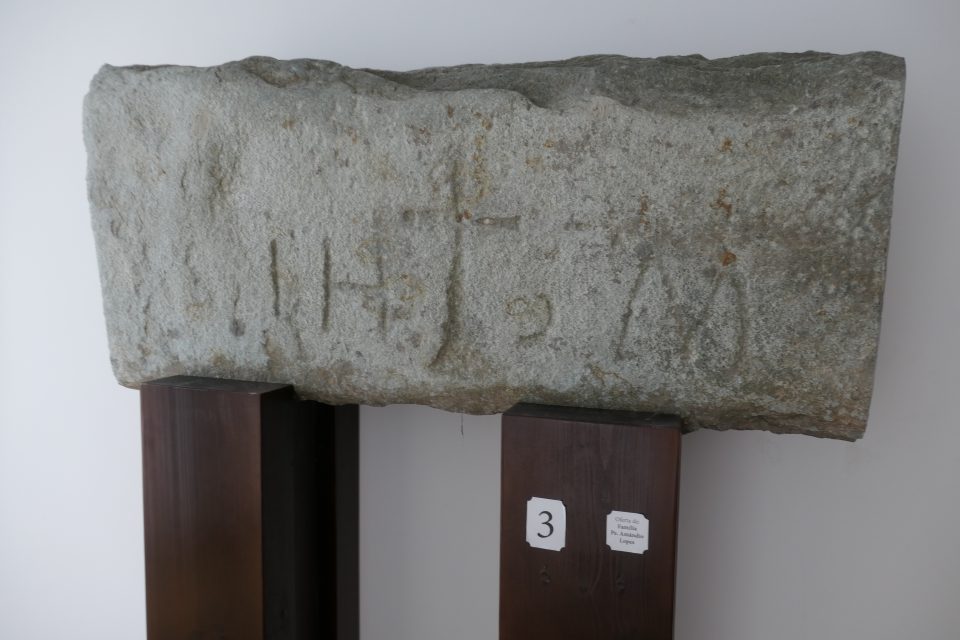
A cross with a triangle at the bottom was one of the symbols that was often placed on the doorposts to indicate this was a home of a New Christian (converted Jew).
The second floor included a wall with the names of Inquisition victims.
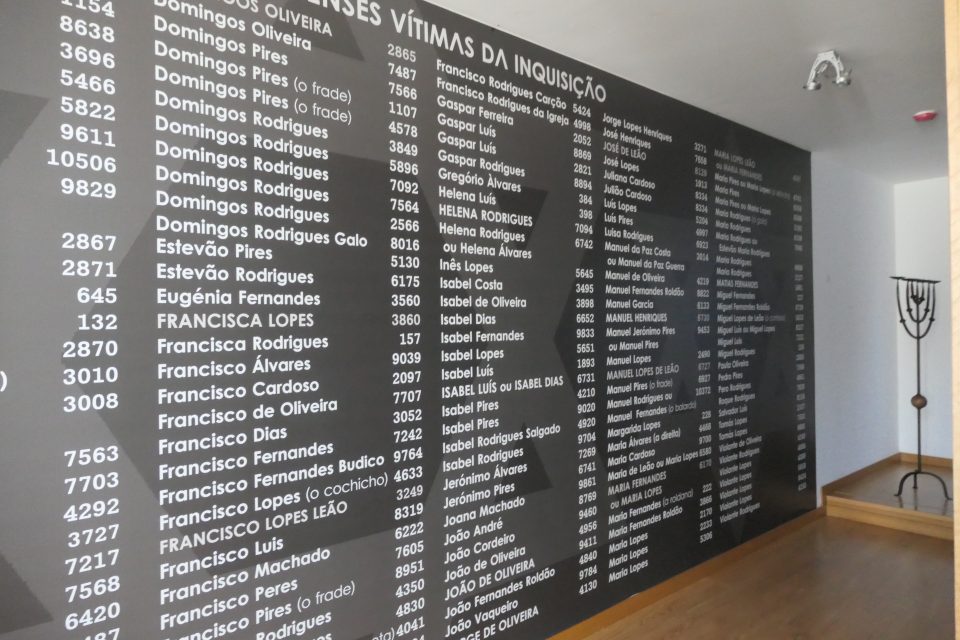
Names of local victims of the inquistion
In the guest book, we noticed there were several entries from about two weeks ago – many entries with the same date. We guessed that tour guides know about this place, and have connections to bring people here.
We walked through several streets that were once the Jewish quarter. Once again, one of the main streets in the Jewish area was Rua dos Gatos – street of the cats. Why?
From Carção we continued to Vilarinho dos Galegos. This is literally a very small village in the middle of nowhere. We drove through beautiful hilly countryside, dotted with small agricultural villages and many newly planted olive groves.
A couple of month ago, we watched a webinar about Crypto-Jewish Music in Portugal. Over the years, the New Christian (converted Jews) women, passed down from generation to generation, songs related to their Jewish faith. The webinar was given by a musician, who traveled from village to village in the area, to record these songs before they disappear. She want to Vilarinho dos Galegos to interview an old woman there. After the interview, she showed a large menorah that had been placed at the entrance to the village, in honor of the Jewish community that once lived there. We were going to try to locate the menorah.
Once we reached the area, the menorah was easy to find.
As we were driving out of the village, we stumbled on our next surprise – a restautant / bar called The Resort of the Jew. It even had a welcome sign in Hebrew. David knocked on the door and an older man answered, who unfortunately did not speak English. Through hand language, we understood that it was called that because this had once been a Jewish area. Two monuments to the Jews in the middle of nowhere, which testify to their important presence here over 500 years ago.
According to my original itinerary for the day, we where to go to one more small village before arriving in Torre de Moncorvo, our destination for the night. It was already late in the afternoon, and we decided to go straight to Torre de Moncorvo. I see that I was a bit over ambitious in planning our days. There is so much to see here, that I scheduled four-five-six towns each day. Maybe in the summertime this would be possible, but now that it gets dark around 5:00, we cannot fit it all in.
Torre de Moncorvo is a large village sitting high on a mountain. The municipality created an app with a route that takes you to nine sites in the city related to its Jewish past. We went first to the tourist office and met Manuel, a young man who seemed very knowledge about the Jewish history of the area. He suggested we meet him tomorrow morning and he will guide us through the sites. Some of the sites are not open to the public, but he can take us there. We arranged to meet at 10:00 the following morning.
Manuel also gave us instructions how to reach a local supermarket. We did a big shopping for supplies and went to our AirBnb. The street address of the place does not exist in Google. The owner provides a small map, but it was hard to follow. It was already dark, and Mark and David walked the streets looking for the house. We telephoned the host, but no answer. She was in France and had arranged for her mother to welcome us. After a frustrating ½ hour, Mark finally found the place.
The Airbnb was up such a steep hill, that our car could not climb it. We parked on the street below, brought in our things, and had the usual evening – cooking dinner and working on our computers. Tomorrow we are supposed to head further south and visit six different places – too much – need now to rethink the day.
Good night.
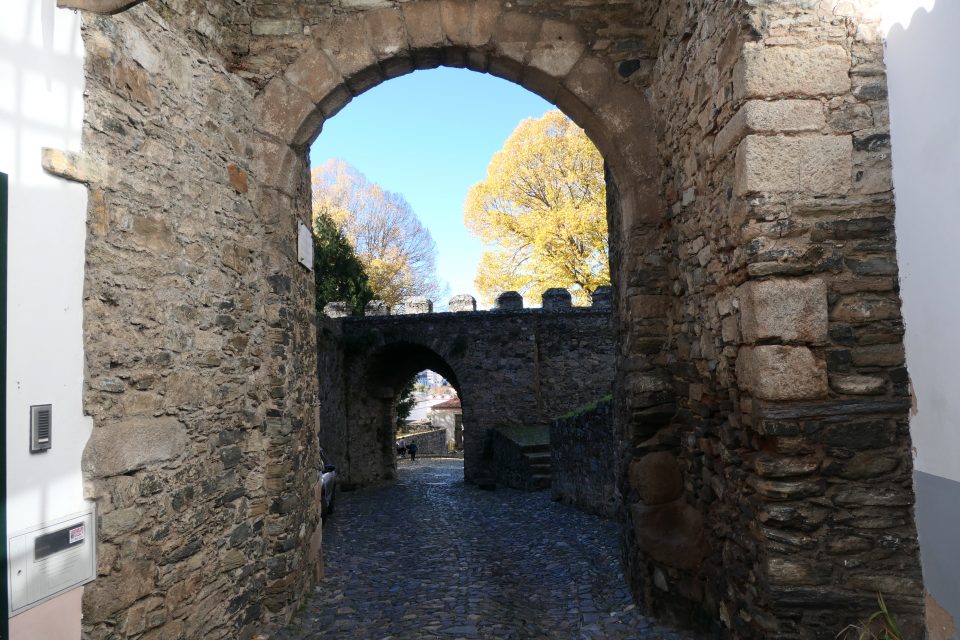
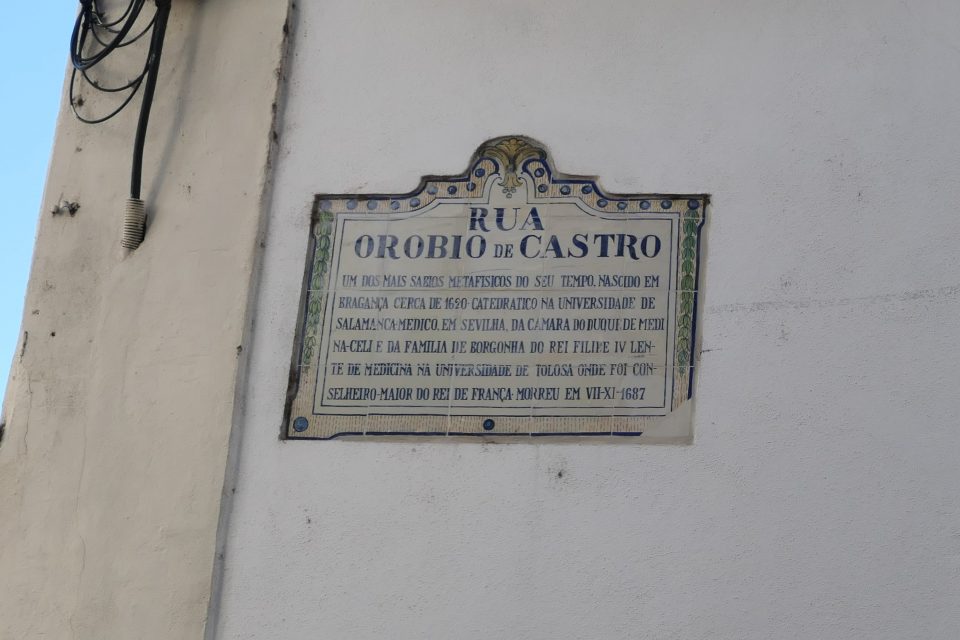
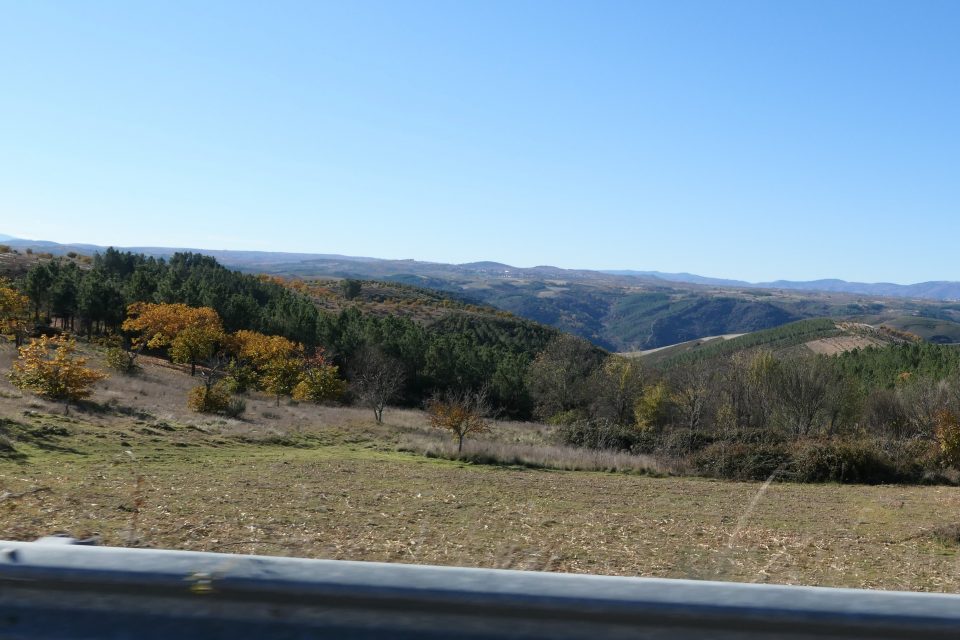
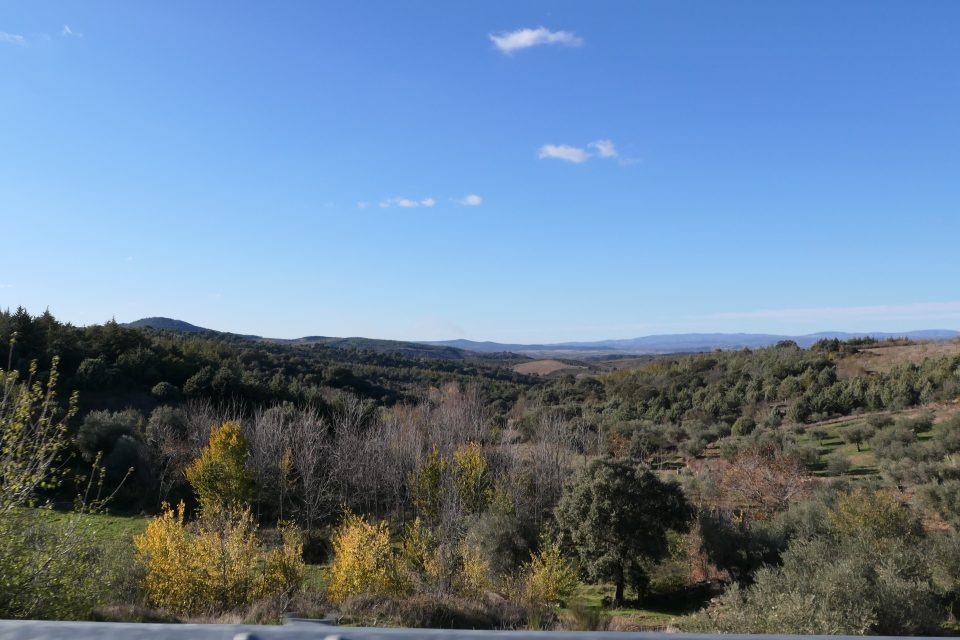
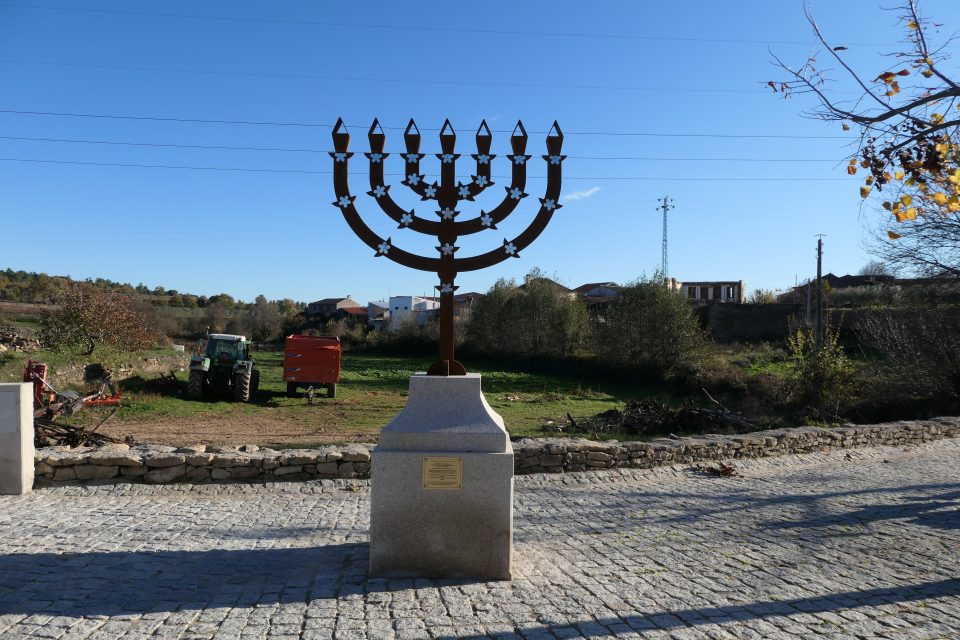
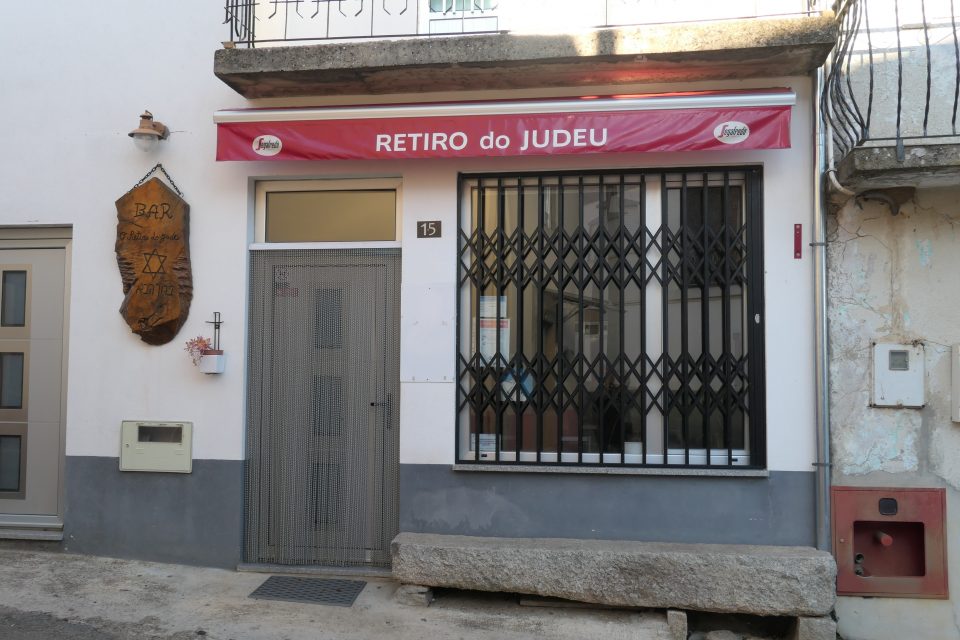
An overarching theme I am getting from your posts is that Portugal did a really good job of eradicating their Jews and their presence (which they are trying to correct now, possibly to increase tourism).
In two places you mention an influx of Jews from Spain in 1942. Did you mean 1492?
I’m trying to find the significance of the cat streets in every Jewish quarter. Perhaps this sheds some light? In this case it’s the name of a famous Jewish home and refers to the lion of Judah https://aldeiashistoricasdeportugal.com/en/local/casa-do-gato-preto/
More on Gato: It was a common surname of converted Jews. Although not sure this is the reason for that common street name, since there were many other surnames. https://www.larraurimarti.com/en/guide-of-frequently-asked-questions-on-the-acquisition-of-portuguese-nationality-for-sephardim-or-their-descendants
This will be my final comment on cats (B”N 🙂). Cats were vilified by the Church and massacred (a contributing factor to the proliferation of rats and hence the plague). Jews, the vilest of creatures, were associated with the cat: “The mythology of the Bible, taken as divine truth, also vilified the Jews as Christ-Killers and during the entire length of the Middle Ages in Europe Jews were linked to the cat as well. Jews were said to worship the cat, were able to transform themselves into cats to sneak into Christian homes to practice mischief or cast spells, and were also believed to crucify cats as a mockery of Christ’s death on the cross. To the patriarchal culture of the Middle Ages, then, the cat was easily the vilest creature to creep across the earth.” https://www.worldhistory.org/article/1387/cats-in-the-middle-ages/
Driving along the Douro river is heading east not west.
The town where Barros Basto is buried is Amarante
Thanks for your kind words about me.